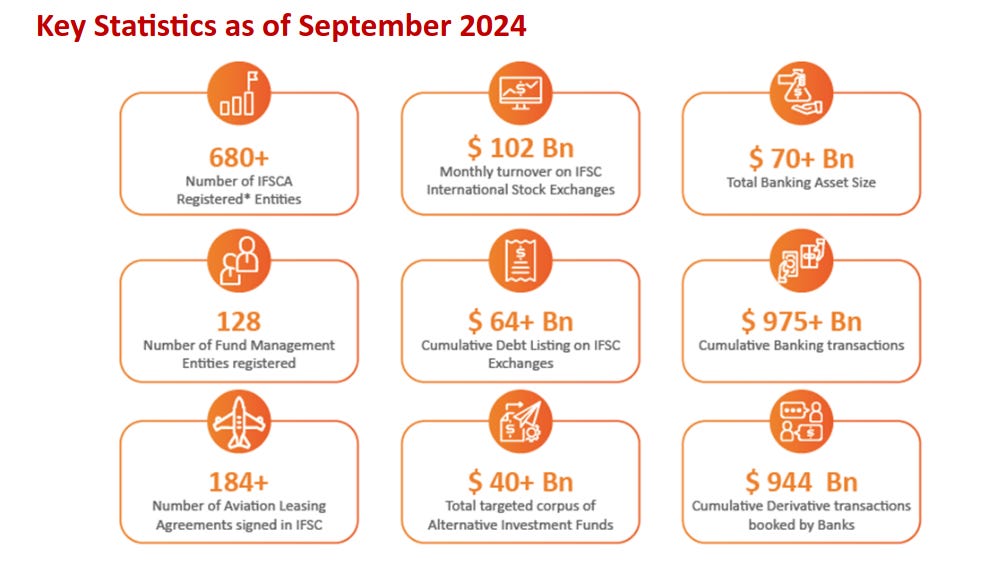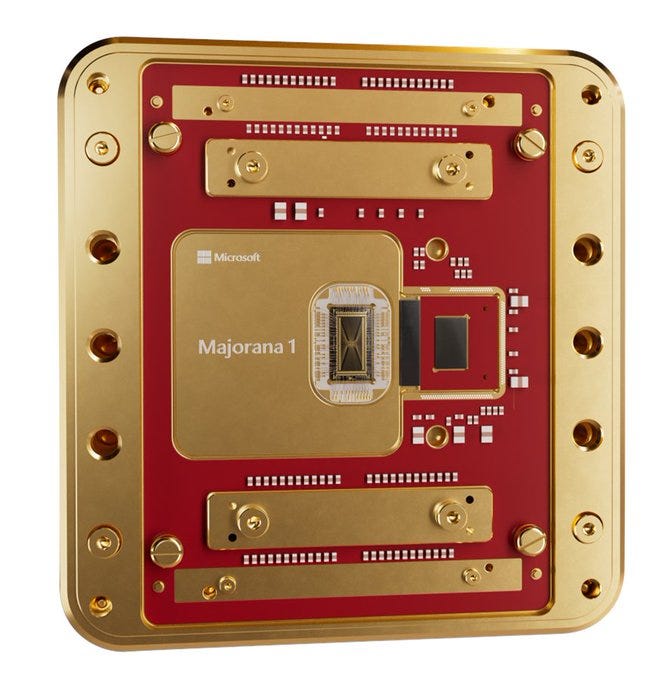Our goal with The Daily Brief is to simplify the biggest stories in the Indian markets and help you understand what they mean. We won’t just tell you what happened, but why and how too. We do this show in both formats: video and audio. This piece curates the stories that we talk about.
You can listen to the podcast on Spotify, Apple Podcasts, or wherever you get your podcasts and videos on YouTube. You can also watch The Daily Brief in Hindi.
In today’s edition of The Daily Brief:
- India’s gambit to becoming an aviation financing hub
- Majorana 1: Future of Computing?
India’s gambit to becoming an aviation financing hub
The Government of India has recently introduced a new bill, which could be a game-changer for Indian aviation. It can substantially reduce what airlines pay to lease aircraft. And it can encourage aircraft leasing within the country, using the Gujarat International Finance Tec-City, or GIFT City, as a hub. This could completely change the country’s aviation landscape. This is why it’s important for us to understand what’s exactly happening.
The aircraft leasing model
Here’s something most people don’t realize: airline companies don’t actually own most of the planes they fly. Instead, these planes are leased by the airlines flying them. This has gone up dramatically over the industry’s life. In the 1970s, just 0.5% of all commercial planes were leased. Today, that figure is over 50%.
In India, though, this pattern is even more pronounced. Over 80% of our commercial fleet is leased.
The reason airlines do this is pretty straightforward. By leasing planes, they avoid the huge cost of buying planes upfront. Instead, they can pay for these planes over time — as they make money from them. It’s quite like the difference between buying and renting a house — except, of course, the numbers involved are dramatically larger. A brand-new Airbus A320neo, for instance, can cost around $ 110 million — a lot of money for any carrier to block at one go.
Meanwhile, leasing the same plane might only cost about $ 300,000 US dollars per month, making it much easier for the airline to manage its finances. With this monthly payment schedule, airlines can immediately recoup the costs of leasing through revenue from ticket sales — allowing them to effectively run a business that would otherwise cost billions. It allows airlines to grow quickly, and replace older planes with newer and more efficient ones — all without tying up too much money in a single aircraft.
The challenges of leasing from abroad
All of that said, there’s a small challenge here, for India. We lease most of our planes from foreign lessors, who sit in jurisdictions like the United States, Singapore, or Ireland. This causes many problems. Airline operators have to navigate tricky regulations across many jurisdictions. Most airline lease agreements are denominated in Dollars, and because they’re paying in foreign currencies, airlines take on huge forex risks. This also creates significant foreign exchange outflows for India as a whole, as airlines pay large monthly lease bills to companies overseas.
India is also seen as a risky destination for aircraft leasing companies. As it is, leasing aircraft is a risky proposition — after all, they’re extremely expensive assets, and if someone doesn’t pay you back, you do not want to be left empty-handed. There’s a global agreement — the Cape Town Convention — that tries to create certainty for leasing companies by making a simple process for repossessing aircraft. But while India signed this agreement, it did not bring its provisions into effect.
This has had serious repercussions in the past. When Indian airlines face financial trouble and cannot meet their obligations, returning these leased planes can be messy. We’ve seen this happen with Jet Airways and Go First, where repossessions became extremely complicated after the airlines went bankrupt. In fact, in 2023, India had to change its bankruptcy laws to make the process of repossession smoother. Because of these problems, last year, the global aviation watchdog, Aviation Working Group, downgraded India’s ratings for airline leasing. This pushed up the cost for Indian companies to lease aircraft even further.
India’s new bill
India wants to shed its image as a risky destination for aircraft leasing. Because of these many tricky issues, it also wants to create a home-grown aircraft leasing option. That’s why the government has introduced a new bill, the Protection and Enforcement of Interests in Aircraft Objects Bill, which is aimed at creating a more favourable regulatory and financial environment for aircraft leasing firms and drawing them into India.
The bill does two things. One, it gives the Cape Town Convention the force of law. It creates a way for them to repossess aircraft more quickly and has provisions that protect creditors on priority.
In addition, this bill gives special benefits to leasing companies operating in GIFT City. GIFT City is designed to work as a global financial hub, with special rules that side-step many restrictions under Indian law. It also has modern infrastructure and tax advantages, which make it even more attractive. The goal of the bill is to attract global lessors to set up shop here, which would reduce our reliance on established leasing hubs like Ireland or Singapore. Here are some of the latest numbers from GIFT City IFSC:
Source: Long Finance
The bill creates complete tax holidays for a set period, and also a unified regulatory framework for aircraft leasing companies in the city, helping them avoid excessive paperwork. It also gives the option to conduct deals in foreign currencies within GIFT City, which helps minimize worries about currency fluctuations.
What does this mean for Indian aviation?
If this bill succeeds, it could mark a turning point for India’s aviation industry. India’s aviation market is growing extremely fast. Currently, Indian airlines have outstanding orders for more than 1,500 new planes, to meet rising air travel demand. By creating a stable, business-friendly environment for aircraft leasing, India has the potential to manage this expansion well — reducing its dependence on foreign lessors, lowering costs for airlines, and retaining more financial flows within the country.
However, success isn’t guaranteed. Global lessors are deeply entrenched in established hubs like Ireland and Singapore, and shifting them to GIFT City will require more than just legal reforms—it will need consistent regulatory clarity, ease of doing business, and a financial ecosystem that rivals the best in the world.
But if India gets this right, it could not only make aircraft leasing cheaper and easier for Indian airlines but also position GIFT City as a serious player in global aviation finance. Over time, this could help India build a self-sustaining aviation industry, reducing its reliance on external financial hubs and reinforcing its status as one of the world’s fastest-growing aviation markets.
Majorana 1: Future of Computing?
Microsoft just announced a new ‘quantum chip’ — Majorana 1.
Source: Satya Nadella’s Tweet
Now, we’re big nerds about everything to do with chips over here, but frankly, we don’t really know what any of this means. As the Arthur Clarke quote goes, “Any sufficiently advanced technology is indistinguishable from magic ”. And so, to us, this whole headline sounded like “Microsoft announces that it did magic. ” That’s a poor foundation if you’re actually trying to understand what’s happening.
Which is why we sat with ChatGPT for hours, trying to understand what any of this really means. And honestly, what we found blew our minds. Here are just five bits of interest to us — though there’s honestly a lot more that we couldn’t cover. We recommend you dig for more.
Why do we need quantum computing at all?
While modern computers are incredible, in the wider scheme of things, they are limited — not because they’re poorly made, but because they’re at the very edge of what is physically possible. If you’re listening to this, you’ve probably seen computer chips get exponentially better throughout your entire life. But the laws of physics won’t allow that for long — we’ve literally shrunk computer transistors to the size of a few atoms, and getting smaller is impossible. A lot of technological innovation, now, is on the workarounds we can find to these limits.
Chips sit at the foundation of a computer. They set the limits for what computing can achieve — the way a car’s engine sets the limits for what it can do. If our chips stop getting better, there’s a limit to how much computing technology can grow as a whole .
Quantum computing is a fundamentally new approach to computers. You probably know that computers, at their heart, work on 1s and 0s. Quantum computers don’t . They play with all sorts of freaky laws of quantum physics — allowing computers to carry exponentially more load than they can today. They’re our most promising solution to the physical limits we’re hitting.
Quantum computers perform freaky magic
Look: at the heart of our computers are ‘bits’. They’re like a switch that can either be on or off. Quantum computers work on ‘qubits’. These are neither on nor off — by some weird magic, they’re both on and off at the same time. Once you look at it closely, though, they ‘choose’ which state they are in. I know this makes no sense: but this is physical reality.
This allows for something incredibly weird: qubits simultaneously do different calculations at once. Some scientists actually think quantum computers try out different bits of math in different parallel universes at the same time, and then spit out the answers. This makes them dramatically faster than anything we can do right now. Problems that would take our latest chips billions of years could be solved by a quantum computer in minutes.
Don’t worry if you don’t understand this. It’s beyond our understanding too. But what’s truly remarkable — beyond how odd the laws of physics are — is that we’re actually able to engineer things that can play with these properties of nature. We can’t do that very well, just yet. But we’re getting there.
The great Google vs. Microsoft game
You probably heard of how Google had come out with a quantum chip too, a few months ago. So, what did that do? And does Microsoft’s new chip do anything different?
Well, here’s the thing: these weird quantum effects play out at an infinitely tiny scale — and even sub-atomic vibrations can throw it off. Because of this, they’re extremely prone to making mistakes. The great challenge of quantum computing is to make things run reliably.
Last year, Google figured something cool with its Willow chip: the more qubits it strung together, the fewer errors it got. So, it combined two things: it built a way to fix errors and then strung millions of qubits together — to a point where it could correct errors faster than they appear.
Microsoft, on the other hand, is trying something radically different. After a decade of research, it introduced a special new sort of qubit — a “topological qubit,” which is less likely to make mistakes in the first place. This is exotic physics and uses something called “Majorana fermions” — something that behaves like half an electron. These are really hard to create or detect.
This whole approach is extremely unusual. Instead of trying to make flawed technology work, Microsoft is basically trying to leap a full generation by using a new, untested technology that could become the new base of quantum computing.
Why should you care?
In an ideal world, there are things we would like to do with computers that are simply not possible. After all, today’s computers have to do one calculation at a time, which stops us from doing really wild stuff.
For instance, a financial firm would like to simulate every conceivable market scenario to create a perfect risk-reward matrix. A government may want to understand, at the level of person-to-person contact, how something like the COVID-19 pandemic can spread. A battery maker might want to understand how individual electrons flow between electrodes, in order to create hyper-efficient batteries. And so on. These calculations are impossibly hard. They would take our best supercomputers billions of years.
These impossibly hard calculations are what a quantum computer is meant to do. It could generate answers to these incredibly hard questions within minutes. According to Satya Nadella, all these things will be possible in just a few years.
This will be a fundamentally new kind of computer — it’ll be nothing like the computers you use today, and it probably won’t ‘replace’ your personal computer. It won’t help you run Excel sheets or play computer games. You’ll probably only see these computers in industries that need to do the hardest calculations you can imagine. And there, these will save billions of dollars.
Are we staring at an arms race?
With Google and Microsoft’s announcements coming within months, we’re possibly seeing the very beginning of a new technological arms race.
Although there aren’t many headlines about this just yet—the way you see for AI, for instance—we’re in the midst of an intense international race to be the first country to crack quantum computing. In the United States, big tech giants are leading R&D efforts, funded by state agencies like DARPA and the NSA. The Chinese government, meanwhile, is pouring billions of dollars into quantum computing, making real innovations in cryptography and secure communications. India, too, has its own National Quantum Mission, though it lags behind countries like the United States and China.
Meanwhile, within the United States, there is active competition between companies like Amazon, Microsoft, and Google—each striving to be the first on the scene.
The first company — or country — to achieve practical quantum computing will have a game-breaking technological advantage across multiple industries. Once it is cracked, all digital encryption will instantly become worthless. One could easily dominate financial markets. A whole new dimension will open up in military and intelligence competition. And so on. The stakes are existential.
We don’t actually understand this yet
This is an extremely experimental story — it’s our best attempt at understanding a highly complicated story that’s only beginning to unfold. A lot of this went way above our heads. And we probably didn’t do a good job of conveying this to you either.
But this moment may well be like 2017 when Google first published the paper that described ‘transformers’. From there, getting to powerful artificial intelligence — including the program that explained all of the above to us — was just a matter of a few short years. The world is already very different, now. If there’s even a chance that we’re at another such precipice, it’s worth trying to understand what’s happening.
This was our attempt at doing that. But we strongly recommend you try the same yourself.
Tidbits
- Vedanta Limited has secured shareholder and creditor approval to demerge into four entities—Vedanta Aluminium Metal, Talwandi Sabo Power, Malco Energy, and Vedanta Iron & Steel. Shareholders will receive one share in each new entity for every Vedanta share held. The exclusion of the base metals business from the demerger signals uncertainty around Vedanta’s stalled Tuticorin copper smelter.
- India’s wheat production faces a setback as rainfall in the northwest wheat belt has been 80% below normal since the start of the year (IMD). January 2025 was the third warmest January since 1901, and forecasts by Maxar Technologies predict continued warm and dry conditions for at least a month. Despite wheat sowing rising 2% YoY to 32.5 million hectares (Farm Ministry), high temperatures could cut yields by over 20%, according to farmers in Haryana. Domestic stockpiles are already at a 16-year low (USDA), raising concerns over food inflation. The government may reduce or scrap the 40% wheat import duty to boost supplies.
- Waaree Energies Ltd. has bagged a 362.5 MWp solar module order, scheduled for execution in FY 2025-26. The deal strengthens its position in India’s renewable energy push, aligning with national solar expansion targets. The order boosts revenue visibility and adds to its growing portfolio of large-scale projects. As India aims for 280 GW of solar capacity by 2030, Waaree’s latest win reinforces its market presence.
- This edition of the newsletter was written by Anurag and Pranav
 Have you checked out One Thing We Learned?
Have you checked out One Thing We Learned?
It’s a new side-project by our writing team, and even if we say so ourselves, it’s fascinating in a weird but wonderful way. Every day, we chase a random fascination of ours and write about it. That’s all. It’s chaotic, it’s unpolished - but it’s honest.
So far, we’ve written about everything from India’s state capacity to bathroom singing to protein, to Russian Gulags, to whether AI will kill us all. Check it out if you’re looking for a fascinating new rabbit hole to go down!
Subscribe to Aftermarket Report, a newsletter where we do a quick daily wrap-up of what happened in the markets—both in India and globally.
Thank you for reading. Do share this with your friends and make them as smart as you are ![]()


